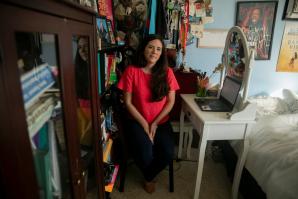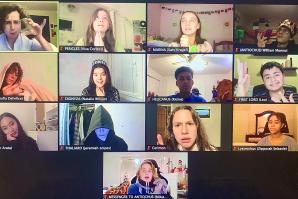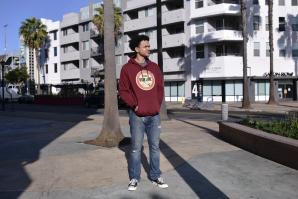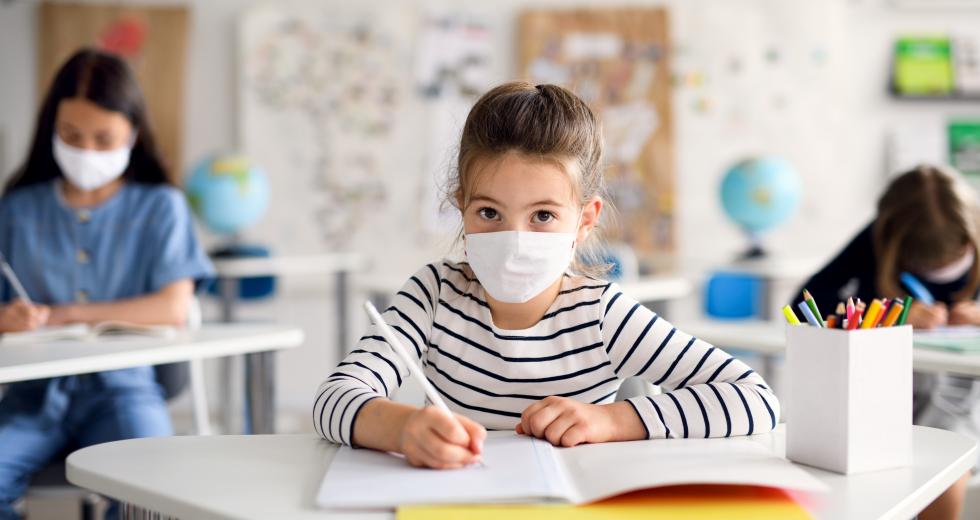School districts in California’s richest neighborhoods are far more likely to offer in-person instruction than those serving its poorest, though the state as a whole remains behind the rest of the country in bringing students back inside physical classrooms, according to a CalMatters analysis of state data.
Public pressure to reopen schools has increased as coronavirus case rates across the state continue to decline. Gov. Gavin Newsom and state legislators remain in high-stakes negotiations on a plan they hope will result in more schools reopening this spring. About three months remain in most school calendars to plot a return this school year.
But school districts in wealthier areas are offering hybrid or in-person learning to greater shares of their students compared with those in California’s poorest areas. As the end of the 2020-21 school year inches closer, only about one-fourth of the state’s elementary students have opportunities for in-person instruction. Even fewer high school students have a chance to attend school in person.
Several larger school districts, such as Long Beach Unified, have begun setting return dates in March and April for some students. The proposal by Democratic state legislators calls on school districts to bring students in kindergarten through sixth grade back on campuses by April 15. As of today, however, California remains among states with the fewest public schools open for full-time in-person instruction or hybrid learning, where students split time at home and in school.
The California Department of Public Health this month began publishing data that offers, for the first time since schools initially closed almost a year ago, a look at which public and private schools are offering in-person instruction to students.
CalMatters analyzed the state’s data on reopened school campuses as of Feb. 23. The state began collecting this data in late January and is updating it as schools report their statuses biweekly. Data on outbreaks in schools that have reopened is still forthcoming.
Here is a look at how school reopenings have progressed in California so far:
In-Person Instruction
Though hundreds of smaller school districts in California physically opened as early as August, most of the state’s students remain in full-time distance learning.
Roughly three-quarters of California elementary students are attending school districts that offer no in-person learning whatsoever.
Though schools self-report their reopening statuses to the state, and are phasing in returns to campus in varying ways, CalMatters defined elementary schools as the state did under its waiver process — kindergarten through sixth grade — for this analysis.
Private schools in California are offering hybrid or in-person instruction to their students at far greater proportions, according to analysis of 1,672 private schools. More than 70% of elementary students attending state private schools have opportunities for in-person or hybrid learning; that proportion for high-school students attending private schools is 42%.
The public-private disparity has been present since as early as September under the state’s elementary waiver program.
Stark Wealth Disparities
A school district’s concentration of student poverty appears to largely indicate whether their school campuses are open or closed.
California’s wealthiest districts — those with less than one-fifth of their students eligible for free or reduced-priced meals, a poverty indicator — are offering hybrid or in-person lessons to a far greater share of students compared with the state’s poorest schools.
Among the state’s richest schools, nearly 7 in 10 elementary students attend a district that’s offering some form of in-person learning. School districts with the highest student poverty — with more than four-fifths of students eligible for free or reduced-priced meals — are offering hybrid or in-person learning to less than 1 in 10 of their students.
Overall, the higher the concentration of student poverty in a district, the less likely it is to currently be offering students some form of in-person instruction.
School Reopenings by County Show Disparate Realities
Newsom and some state lawmakers have increasingly called for schools to reopen this spring, but much of the actual decision-making rests with local school boards, superintendents and teachers unions. That’s resulted in disparate realities playing out across the state’s 58 counties, where some have most school campuses open in some form, while school districts in other — sometimes neighboring — counties remain mostly closed.
Elementary schools in more than two dozen counties mainly in Northern California and the Central Valley, for example, are almost all offering either hybrid or in-person learning. Most of these counties have smaller student populations.
In Los Angeles County, hit hard by the pandemic, less than 10% of districts’ elementary students have been offered in-person learning opportunities. The picture is different in next-door Orange County, where about two-thirds of elementary students have had opportunities for some in-person instruction.
State legislators criticized the state’s haphazard picture of school reopenings at a Monday budget hearing.
“I am normally a huge proponent of local control,” said Assemblymember Phil Ting, a San Francisco Democrat. “But this year local control has been a complete failure.”
CalMatters.org is a nonprofit, nonpartisan media venture explaining California policies and politics.
–
Stay up to date on the effects of the coronavirus on people and business in the Capital Region: Subscribe to the Comstock’s newsletter today.
Recommended For You

‘Too Little, Too Late’
California small businesses chase COVID-19 relief
As new state grants, tax credits and federal loans roll out, small business owners say their survival will depend more on reopening rules, red tape and resolving unemployment chaos. What happens next will shape the state’s job market for years to come.

For Many Californians, the Pandemic Marks the End of ‘Barely Making It’
The pandemic is accelerating the demise of the middle class, leaving many unable to sustain financial independence. In Silicon Valley and elsewhere, middle-class workers have found themselves unable to make rent.

Lights, Camera, Virtual Theater
Northern California School of the Arts brings shows to the small screen
The services provided by NorCal School of the Arts aim to support teachers and students in building community and improving mental health in unprecedented times.

Community College Enrollment Falls as Students Grapple With Job Loss, Online Learning
Enrollment at California community colleges is down more than 9 percent from the year before, confounding the predictions of some higher education experts that community college enrollment would rise this fall, as it has in previous recessions.



